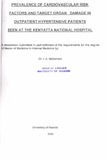| dc.description.abstract | BACKGROUND Hypertension is a well-established, common and powerful predisposing factor for the development of coronary heart disease, stroke, heart failure and renal
failure.Furthermore hypertension seldom occurs in isolation, but tends to occur in
non with other artherogenic risk factors that not only promote its occurrence but
also greatly influence its impact on cardiovascular disease. Unfortunately there is a rapid
development of the 'second wave epidemic' of cardiovascular disease that is now flowing
through developing countries most of which are already in economic difficulties. Scanty
data exists locally on the prevalence of cardiovascular risk factors and target organ
damage amongst the hypertensive population.
OBJECTIVES The aim of the study was to determine the prevalence of CVRF; cigarette
smoking,obesity, dyslipidaemia, diabetes mellitus, ECG-LVH, and TOO; clinical cardiac
disease, cerebrovascular accident, nephropathy and hypertensive retinopathy in
hypertensivepatients seen in medical outpatient clinics at KNH.
METHODS A random sample of hypertensive patients seen at the MOPCs of KNH was
selected and data obtained on age, sex, duration and treatment of hypertension, history
of cigarettes moking, and family history of hypertension, diabetes and vascular disease in
first-degree relatives. BMI, WHR and resting BP were recorded. Fundoscopy and a 12lead
Electrocardiogram were performed on the patients. A fasting venous blood sample
was drawn to determine, fasting lipid profile (TC, HOL-C, LDL-C and triglycerides), FBG
and serum creatinine. A spot specimen of urine was screened for proteinuria using a
dipstick.
8.6%)using 2 or more drugs. Twenty-seven patients (29.3%) had history of cigarette
smoking: 6.5% current smokers (all males) and 22.6% ex-smokers. Family history of
hypertension was 43.0%, diabetes 20.4% and vascular disease in first-degree relatives
5.4%. The mean BMI was 27.5 kg/m2 [26.6 - 28.5, 95% C.I], with 66 patients (71.0%)
being either overweight or obese and 27 patients (29.0%) having central obesity. The
meanSBPwas 151 mmHg [147 -155,95% C.I], mean DBP was 95 mmHg [92 - 97,95%
C.I], with 20 patients (21.5%) having their BP controlled « 140 /<90mmHg).
Dyslipidaemiawas found in 65 patients (69.9%). The mean fasting blood glucose (FBG)
was5.9rnrnol/l, with 9 patients (9.7%) having diabetes. Of the 9 diabetic patients, 6 were
newly diagnosed. ECG-LVH was observed in 30 patients (32.2%). Thirty patients (32.3%)
had clinical cardiac disease with 18 (19.4%) having CCF and 14 (15."1%) having CHD
(anginaor previous MI). Eleven patients (11.8%) had cerebrovascular accident while 20
(21.5%) had nephropathy. The mean creatinine clearance was 86.1 ml/min with 39
(41.9%) having creatinine clearance of 60 - 89.9 rnl/min. Four patients (4.4%) had
proteinuriaof > 30 mg/dl. Hypertensive retinopathy was detected in 60 patients (64.5%).
Nearly all patients (96.8%) had at least one other CVRF and 76.3% had at least one target
organ damage.
CONCLUSIONS There is a high prevalence of vascular risk factors and target organ
damage,frequently multiple, in patients with hypertension seen at KNH. | en_US |
| dc.description.department | a
Department of Psychiatry, University of Nairobi, ; bDepartment of Mental Health, School of Medicine,
Moi University, Eldoret, Kenya | |

